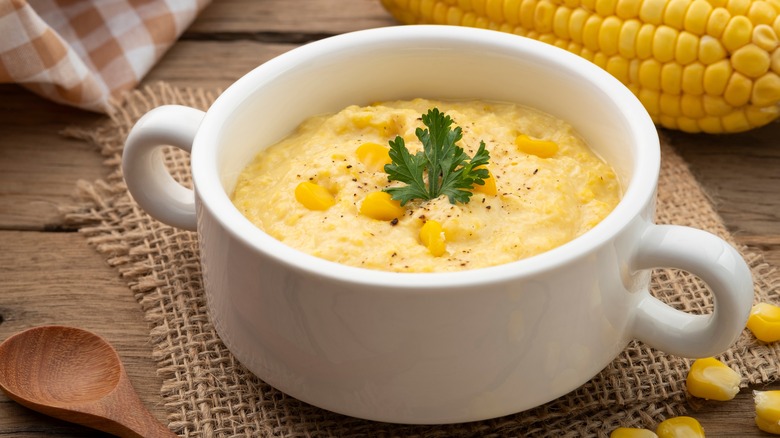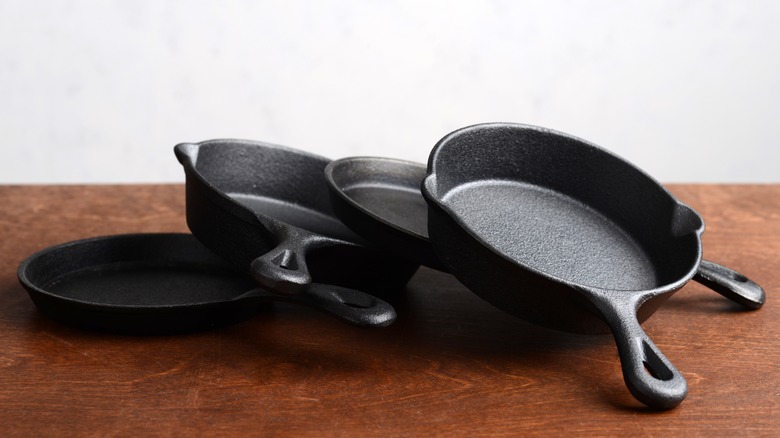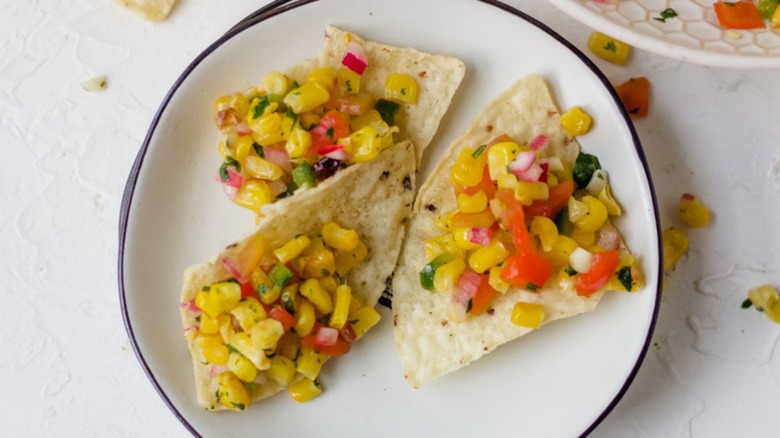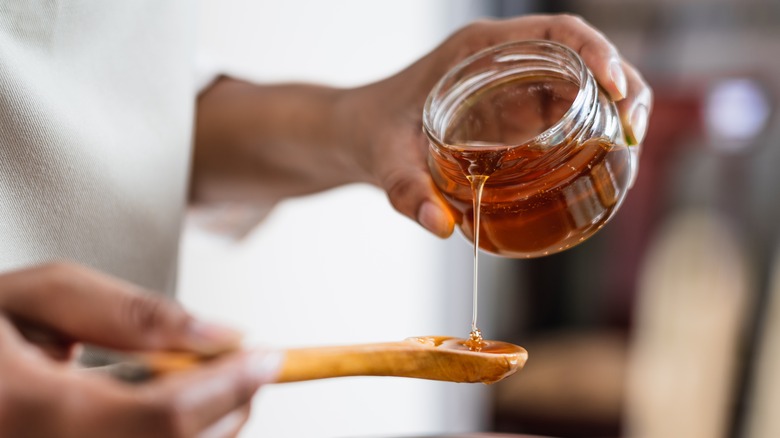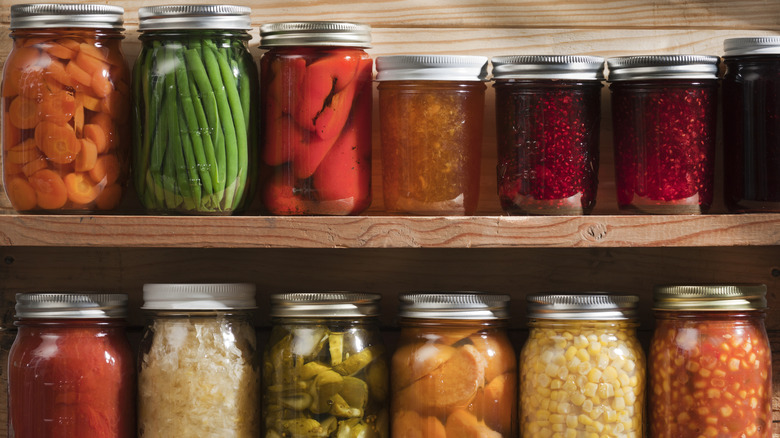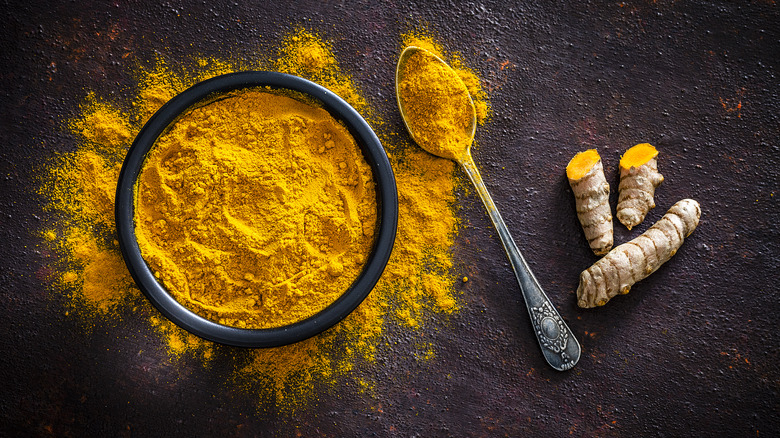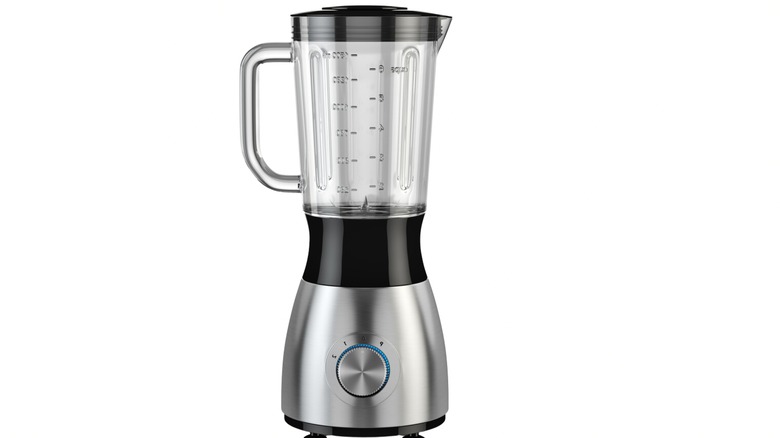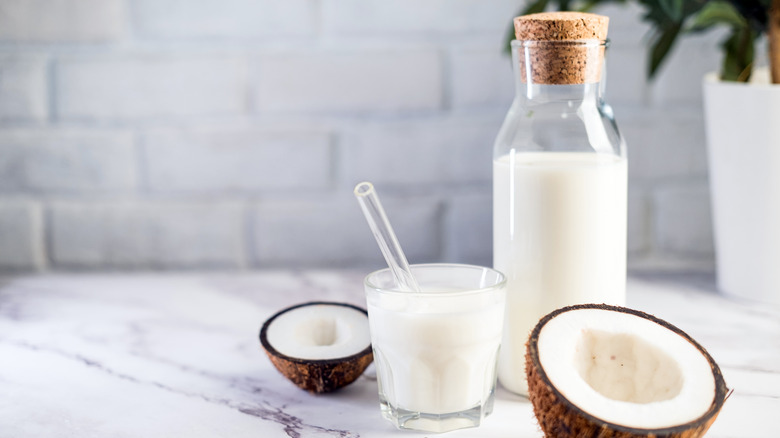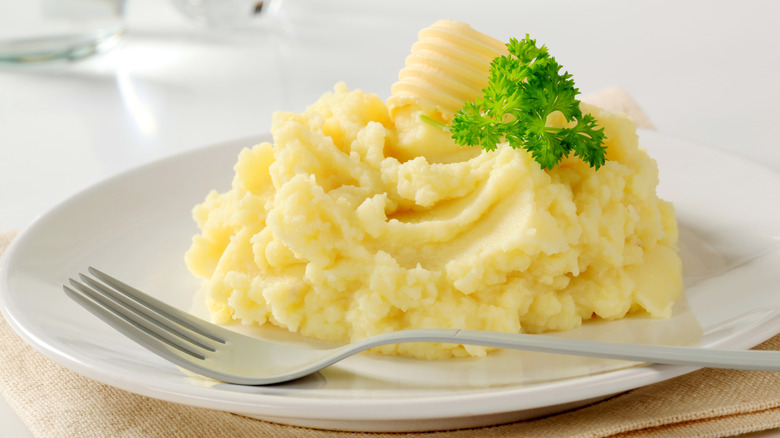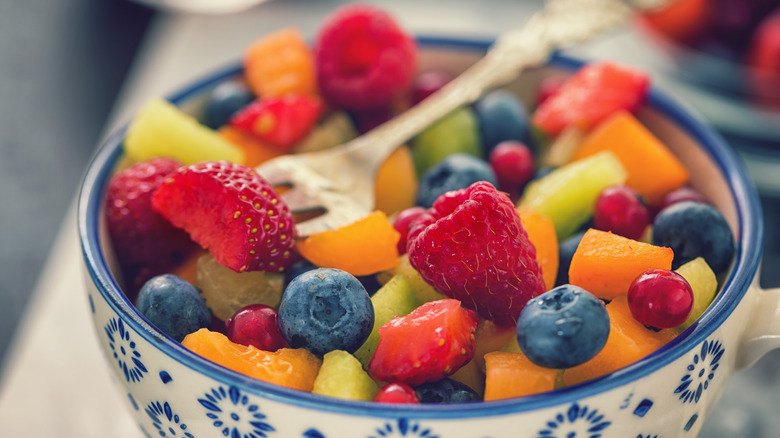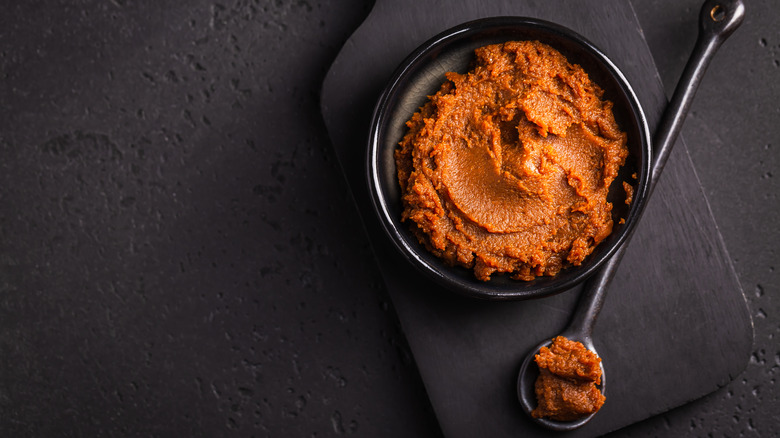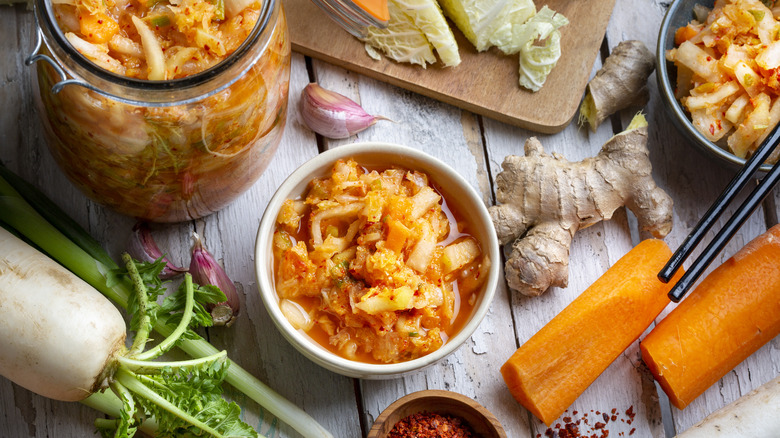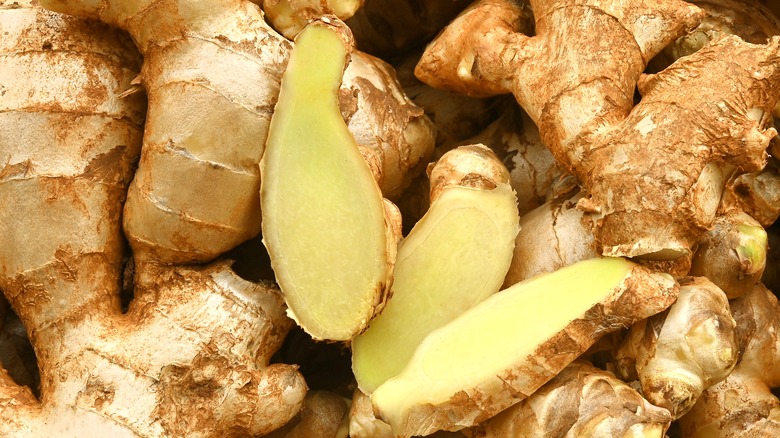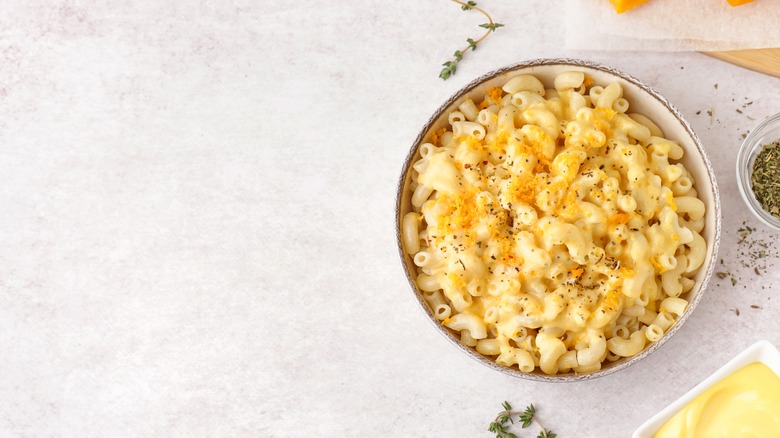13 Unique Ways To Upgrade Your Canned Corn Side Dish
Whether you're preparing for a summer barbecue or looking for a new side dish to spice up your Thanksgiving spread, corn is an obvious choice that just about anyone will enjoy. Even though we all know it's a vegetable, it tastes so much more indulgent than a bowl of broccoli or a handful of steamed green beans, and with its light crunchiness, it provides a welcome textural variation to any number of dishes. You can add it to stir-fries, soups, and even salads, or just add a little butter, salt, and pepper and serve it on its own.
If you're planning to make a canned corn side dish, however, you might be wondering how you can spruce up this simple veggie to make it a stand-out part of the meal. The beauty of canned corn is its ease of preparation and versatility. All you have to do is open the can and heat it (or not, depending on the recipe).
Given how much effort you're saving by using this canned ingredient, why not take a little extra time to upgrade it? We've got all the options you need to seriously up your canned corn side dish game. From cooking and preparation techniques to ingredient combinations that are a match made in culinary heaven, these ideas will kickstart a whole new appreciation for the humble can of corn, whether it's already one of your go-to ingredients or not.
1. Pan fry it
When you're trying to make a quick side dish but don't want to simply heat canned corn in the microwave with a dab of butter, pan frying is a surprisingly transformative option that takes less than 20 minutes. Mashed recipe developer Kate Shungu has a blueprint for making this dish, though you'll need to alter it slightly to accommodate the extra moisture in canned corn compared to fresh. That's because pan frying becomes steaming if the thing you're trying to fry is full of moisture. So, before proceeding with the recipe, dump the corn into a colander and let it drain. You might even want to apply some gentle pressure here, then pat it dry to extract as much liquid as possible.
Once the main ingredient is relatively dry, the process is straightforward. Add bacon grease and butter to a hot skillet and mix in the corn, sugar, and salt. The most pivotal ingredient in the recipe is flour. Because the corn isn't being deep-fried, flour plays a different role than it does in breaded foods like fried chicken, where it forms a crispy crust. In this recipe, the flour instead helps to make a thick, velvety sauce without the need for milk or cream. As a result, pan-fried corn kernels are salty, sweet, and creamy with a hint of caramelization.
2. Double down with corn chips
Corn is a multi-billion dollar industry in the U.S., and although most of it is used for animal feed, it still crops up in a surprising range of foods that humans consume. Corn syrup alone is found in everything from Coca-Cola to ketchup. But you don't often see the ubiquitous veggie paired with itself very often, which is a shame, because tortilla chips piled high with creamy corn dip or corn-based salsa is something we all deserve to enjoy. The sweetness of fresh corn combined with the salty crunch of corn chips is a natural pairing, and once you discover it, you'll be looking for ways to incorporate it into your meals more often.
This creamy corn dip is a great place to start. Made in just 15 minutes, it contains avocado, scallions, jalapeño, and cheddar cheese (among other things) for a rich, spicy, concoction that makes an excellent appetizer. For something a little lighter, try this roasted corn salsa. It calls for lightly charring the corn in the oven to give it a smoky flavor before tossing the kernels with tomatoes, garlic, lime juice, jalapeños, red onion, and cilantro.
3. Add honey
No matter how insistent we are that corn is a vegetable that belongs in savory dishes, the fact remains that it's packed with sugar. One hundred grams of sweet corn contains over six grams of sugar, which is more than the same amount of sweet potato and even more than strawberries and raspberries. You probably wouldn't want to add berries to your chicken noodle soup, but somehow, everyone is happy to add corn. This has more to do with the versatility of corn than its specific aptitude for savory dishes, but we think it's high time to switch things up with a sweet recipe. Enter: corn with honey.
In addition to all its natural sugar content, you can add more sweetness to corn and get an even more delicious result. This is one of the easiest ways to upgrade canned corn since all you need to do is add a single ingredient. Really: all you have to do is add a small amount of honey to the corn, stir, taste, and adjust from there.
To make it even more appealing, however, you may as well go the extra mile and add plenty of butter and maybe even a little cream cheese or cream. You can serve this dish as a side for a savory meal or use it as a condiment on sweet treats like ice cream and cake.
4. Pickle it
Pickling is so closely associated with cucumbers that the word pickles is, to many, synonymous with this particular produce. But you can pickle just about anything, and we think corn is one of the most underrated options.
The process of pickling was originally intended to extend the shelf life of certain foods, but now that we have modern refrigeration, artificial preservatives, and canning techniques, it's done more often for flavor than preservation. There are two main ways to pickle. The fastest and most common option is to soak vegetables in a solution that is typically made of water, vinegar, and salt, along with additives like seasonings and, sometimes, sugar. The other requires fermentation in salt water and is largely associated with products like sauerkraut and kimchi.
For the quickest pickled corn, you should opt for the vinegar brine. Once you've dissolved sugar and salt in the water and vinegar solution and added the corn, you only need to let it sit in the fridge for a few hours before digging in. This route has the added benefit of being highly adaptable. As Tasting Table notes, there is a ton of room for variation here. You can swap white vinegar for Champagne or apple cider vinegar, increase or decrease the sugar, and include any spices or additional veggies you like. With minimal effort, you'll have a jar of sweet, tangy corn kernels to elevate salads and tacos ... or to simply enjoy by the spoonful.
5. Add curry powder
There are some ingredients that completely transform the flavor of a meal. Garlic is an example of this, as is lemon juice. One of the most distinctive members of this group is curry powder, whether it's the faintly sweet notes of madras or a heartier classic tandoori mix. For the simplest twist on basic canned corn, all you need to do is add your favorite curry blend to a pre-existing dish (our creamed corn recipe is an ideal candidate).
For a more Indian-inspired dish, however, you'll need to put in a little extra time. Instead of simply adding spice to corn, you can create a curry dish that highlights corn as the main ingredient. For example, saute onions, garlic, curry powder, and potatoes with the corn before adding coconut milk or stewed tomatoes. You can even dial up the spices with cardamom, fresh ginger, cumin seeds, turmeric powder, and chili powder. Whatever option you choose, the sweetness and juicy crunch of the corn will shine through, suffused with the warm spices.
6. Puree it
Blending ingredients can completely change how they are perceived. For example, raw garlic, basil, parmesan cheese, and pine nuts aren't nearly as appetizing when combined in their whole forms as they are when blended into pesto. Likewise, most of us wouldn't be particularly excited about eating raw kale and bananas unless they're blended into a smoothie. Corn is delicious on its own, but it too can benefit from blending. Aside from corn soup and chowder, turning it into a kind of hummus is an easy way to present this ubiquitous ingredient in a way that will surprise and delight your dinner companions.
Because it isn't as starchy as chickpeas, the star ingredient of hummus, corn doesn't become creamy when blended. This means that you'll need to make the hummus chickpea-based (or use another starchy veggie like edamame). You can use our lemon hummus recipe as a starting point and add canned corn in small portions, tasting after each addition until you achieve the flavor and consistency you're after. For an elegant garnish, serve the hummus in a bowl topped with corn kernels and feta cheese. With crackers or slices of pita bread, this dip is a deliciously sweet snack that your guests will marvel over.
7. Swap cream for coconut milk
Many corn side dishes contain cream. It provides a richness that complements the crisp sweetness of the vegetable and helps bind all the ingredients together. Aside from a light, milky flavor, however, cream doesn't provide much in the way of taste. An easy way to change that without drastically changing the recipe or lowering the fat content is to swap it for coconut milk.
With its rich consistency and subtly sweet, nutty flavor, coconut milk is a natural fit for the fresh, sugary taste of corn. If you're making a simple creamed corn side dish, you can simply use coconut milk in place of cream and milk, since it has plenty of fat to compensate for the cream and enough liquid to compensate for the milk. The resulting dish can be served as a side to accompany just about any entree, or could be added to other recipes like this delicious and filling corn pudding.
8. Mash it with potatoes
To many diners, mashed potatoes are the gold standard of side dishes. Creamy, starchy, and salty, they are indulgent without being decadent and can both moisten a dry main dish (such as turkey or beef) and soak up excess liquid (such as gravies and stews). They are perfect as-is, but there's always room to experiment with new flavors, even when you're dealing with a time-honored classic. In addition to butter, milk, garlic, salt, and pepper, corn is one of the best additions to this stalwart side, providing pockets of sweetness and crunch that add variation to the otherwise uniformly smooth texture.
The process is simple. Proceed with your favorite mashed potatoes recipe. Then, when the time comes to mash the ingredients, add the corn. The ratio is up to you. If you want the kernels to be a mere hint of flavor, add a scant amount. If you want it to be on equal footing with the potatoes, add more. You can even choose whether you want the corn to be mashed into the potatoes to create a smoother texture, or added afterward to maintain the shape and juiciness of the individual kernels.
9. Pair it with fruit
Highlighting the sweetness of corn instead of forcing it to be the singular sweet ingredient in a savory recipe will make you see the veggie in a new light. This doesn't mean that you have to start making complicated corn-based desserts, however. In fact, one of the best ways to use its natural sweetness is to pair it alongside other naturally sweet ingredients, such as fruit. A simple fruit salad already makes for a visually arresting and flavorful side dish, whether you're preparing for an outdoor potluck in July or simply looking for a way to inject some newness into your usual weeknight meals. Why not add corn?
It's hard to go wrong with fruit salad. Apples, grapes, berries, oranges — it's all fair game. Add a little lemon or orange juice to the mix to bring it all together and you'll have a quick, vitamin-packed side dish. Because of its neutral sweetness and juicy texture, corn is an equally low-maintenance ingredient. You don't need to worry about flavor or texture clashes. Simply toss it into the mix and enjoy its bright color and surprisingly seamless taste.
If you want to flip the script and make the fruit salad savory, add some onion, feta cheese, and fresh herbs. Although these may sound like incongruous pairings, they provide a pleasing contrast for your tastebuds and will act as a palate cleanser between bites of other dishes.
10. Add miso
When you want to elevate a savory dish, miso is a one-stop-shop to do it. The fermented soybean paste with its rich umami flavor is the secret ingredient in many Japanese dishes and can be used in a wide variety of dishes, from grilled meat to creamy yellow squash soup. Given its range, it comes as no surprise that miso is also a delicious addition to corn side dishes, with its deep flavor helping to balance the sweetness of the yellow veggie.
Miso is a paste, which means that adding it to a recipe is pretty straightforward. No chopping, juicing, or grating is required. A quick option is to mix miso paste with butter in a 1:2 ratio and add it to the pan in which you're heating the corn. If you want something more complex, you can create a sauce or marinade that revolves around the soybean paste and douses the corn in flavor.
Regardless of how you use the miso, however, it's important to know which type you're using. There are many variations, but the ones you're most likely to find are white (shiro) miso and red (aka) miso. White miso undergoes a shorter fermentation period and therefore has a milder, less salty taste. Red miso, on the other hand, has a more powerful and deep salty flavor. You can use both in corn recipes, but you'll need to account for their different strengths.
11. Ferment it
Fermentation has grown in popularity in recent years, particularly in the form of the Korean staple, kimchi. With its sharp, tangy flavor, kimchi can be used in many unexpected ways and is known to provide the healthy bacteria that help your gut microbiome thrive. Although vegetable fermentation might seem like a recent fad in the U.S. to some, the reality is that cooks in the eastern part of the country have been making fermented food for generations, specifically with corn.
Also known as sour corn, fermented corn is a staple of southern Appalachian cuisine. It's made by soaking the kernels in brine for up to seven days at room temperature, producing a distinctly sour flavor. Unlike pickling, which often involves soaking veggies in a vinegar and water solution for a few hours, this process requires more extended fermentation rather than marination. The resulting kernels are a tasty addition to salads and a delicious replacement for relish on hotdogs and burgers, providing a refreshing sourness.
Despite the fermentation process, the corn kernels maintain their structure, ensuring that you'll still get to enjoy a nice crunch when you bite into them. Just make sure to store them in the fridge once they've finished fermenting.
12. Add ginger
Like curry powder and garlic, ginger is one of those ingredients that can completely reshape a recipe. Corn has a subtle enough flavor that even the smallest amount of ginger can make a dramatic difference, so adding it requires that you maintain a delicate balance. One of the best ways to avoid turning your corn dish into a ginger dish is to layer more flavors into the recipe. Garlic and ginger will always complement each other, and sauteing them in a skillet to round out their flavors before adding the corn is an easy way to elevate the veggie without overcomplicating things. You can also add some chili powder to the mix if you like a bit of heat.
Another option is to incorporate finely grated or blended ginger into butter before then incorporating it into the corn. Just keep in mind that if you aren't sauteing it, the ginger will be spicy. When introduced to heat, such as through cooking or baking, one of the compounds in fresh ginger, known as gingerol, transforms into zingerone, a compound that is milder and slightly sweet.
13. Treat it like macaroni
Corn probably isn't at the top of your list of macaroni substitutes, but you might reconsider when you try this Korean recipe. Corn cheese is a dish that is so simple and delicious you'll wonder why you haven't been making it for years once you try it. Think of it as creamed corn but with lots of gooey, melted cheese. Pretty much everything's better with cheese, as far as most people are concerned, and it turns out that corn is no exception.
To make Korean corn cheese, you'll need corn (of course), as well as butter, mozzarella, mayonnaise, salt, pepper, sugar, and green onions for garnishing. If you want a mild version that can stand in for macaroni and cheese, these ingredients are sufficient. Cook them in a skillet on the stove or a baking dish in the oven until the cheese is melted and gooey. For a spicier and more complex version, add doenjang, a fermented soybean paste that, like miso, provides a powerful umami flavor.
